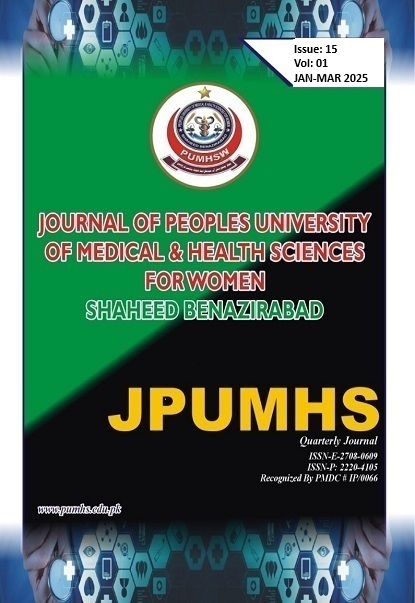PREVALENCE OF MUSCULOSKELETAL DISORDERS AND ITS CORRELATION TO PHYSICAL ACTIVITY AMONG UNDERGRADUATE HEALTHCARE STUDENTS.
JPUMHS; 2025:15:01, 43-49. http://doi.org/10.46536/jpumhs/2025/15.01.594
Keywords:
Musculoskeletal disorders, Physical activity, Undergraduate healthcare students.Abstract
BACKGROUND: Musculoskeletal disorders (MSDs), characterized by self-reported musculoskeletal strain, are among the conditions that physical activity (PA) can help prevent. Conversely, insufficient PA increases the risk of developing MSDs. In Malaysia, studies have shown that musculoskeletal pain is prevalent among medical undergraduates, influenced by factors such as a family history of trauma and academic-related stressors. This study aims to determine the prevalence of MSDs and assess how these disorders affect levels of physical activity in undergraduate medical students. OBJECTIVE: study was planned to explore the prevalence of MSDs and its correlation to PA in undergraduate healthcare students. METHODS: The cross sectional study was carried out among the medical students of various subjects for the time period of 06 months. Total 403 sample were selected through convenience sampling technique. Standardized Nordic Musculoskeletal Questionnaire (NMQ) and Physical activity measured through IPAQ questionnaires were used to assess the sensitivity and severity of musculoskeletal pain. RESULTS: From the collected data, it was observed that 32.5% (131) were involved in less physical activity during their routine work whereas 23.1% had maintained their life with routine exercise. The severity of pain was different among medical students as low back pain was observed among 59.3%, followed by neck pain 55.3%, shoulder pain 54.6%, upper back 43.9%, wrists/hands 40.4%, and ankles/feet 36.5%. There was a significant association between the musculoskeletal disorders in elbow, knee and ankles/feet region with the level of PA. CONCLUSION: The present study revealed a high prevalence of musculoskeletal disorders among undergraduate medical students, with pain most frequently reported in the lower back (59.3 %), neck (55.3 %), and shoulder (54.6 %). A subset of participants maintained sufficient levels of physical activity to permit analysis of the relationship between musculoskeletal complaints in the elbow, knee, and ankle/foot regions and overall activity level.
Downloads
Downloads
Published
How to Cite
Issue
Section
License

This work is licensed under a Creative Commons Attribution-NoDerivatives 4.0 International License.




